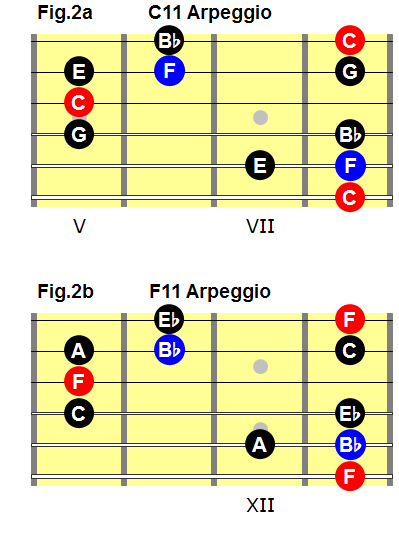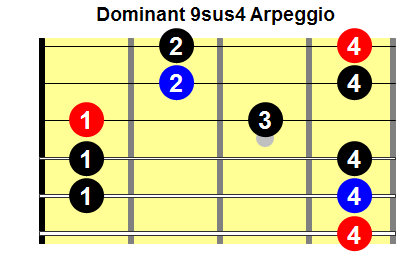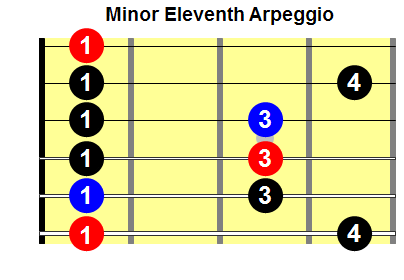We continue our study of extended arpeggios with an analysis of eleventh chord arpeggios.
This post will provide fingerings for eleventh chord arpeggios, along with instruction on how to play the arpeggios on a guitar with any root note.
Dominant Eleventh Arpeggios
The chord formula for a dominant eleventh chord is 1, 3, 5, b7, 9, 11.
A dominant eleventh arpeggio fingering contains the same notes as a dominant eleventh chord — the first, third, fifth, flatted seventh, ninth and 11th degrees of the major scale with the same root note.
Both a C11 chord and a C dominant eleventh arpeggio fingering contain the notes C, Eb, G, Bb, D and F — the first, third, fifth, flatted seventh, ninth and 11th notes in a C major scale.
Fig.1 shows a common fingering for a dominant eleventh arpeggio, the eleventh scale degree highlighted in blue. The ninth scale degree has been omitted from this fingering.
Fig.1

This fingering will allow you to play a dominant eleventh arpeggio starting on any note:
- To play a C dominant eleventh arpeggio, start the pattern on the C on the sixth string, eighth fret (fig.2a).
- To play an F dominant eleventh arpeggio, start the pattern on the F on the sixth string, 13th fret (fig.2b).
Fig.2

Dominant Ninth, Suspended Fourth Arpeggios
The chord formula for a dominant ninth, suspended fourth chord is 1, 4, 5, b7, 9.
A dominant ninth, suspended fourth arpeggio fingering contains the same notes as a dominant ninth, suspended fourth chord — the first, fourth, fifth, flatted seventh and ninth degrees of the major scale with the same root note.
Both a C9sus4 chord and a C dominant ninth, suspended fourth arpeggio fingering contain the notes C, F, G, Bb and D — the first, fourth, fifth, flatted seventh and ninth notes in a C major scale.
Fig.3 shows a common fingering for a dominant ninth, suspended fourth arpeggio, the fourth scale degree (same note as the 11th scale degree) highlighted in blue.
Fig.3

This fingering will allow you to play a dominant ninth, suspended fourth arpeggio starting on any note:
- To play a C dominant ninth, suspended fourth arpeggio, start the pattern on the C on the sixth string, eighth fret (fig.4a).
- To play an F dominant ninth, suspended fourth arpeggio, start the pattern on the F on the sixth string, 13th fret (fig.4b).
Fig.4

Minor Eleventh Arpeggios
The chord formula for a minor eleventh chord is 1, b3, 5, b7, 9, 11.
A minor eleventh arpeggio fingering contains the same notes as a minor eleventh chord — the first, flatted third, fifth, flatted seventh, ninth and 11th degrees of the major scale with the same root note.
Both a Cm11 chord and a C minor eleventh arpeggio fingering contain the notes C, Eb, G, Bb, D and F — the first, flatted third, fifth, flatted seventh, ninth and 11th notes in a C major scale.
Fig.5 shows a common fingering for a minor eleventh arpeggio, the eleventh scale degree highlighted in blue. The ninth scale degree has been omitted from this fingering.
Fig.5

This fingering will allow you to play a minor eleventh arpeggio starting on any note:
- To play a C minor eleventh arpeggio, start the pattern on the C on the sixth string, eighth fret (fig.6a).
- To play an F minor eleventh arpeggio, start the pattern on the F on the sixth string, 13th fret (fig.6b).
Fig.6

Related Posts
Related posts include:
